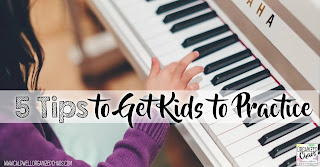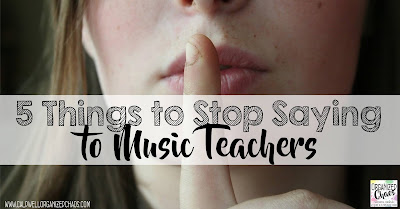I love taking some time for reflection at the end of each year, so today we're taking a look back at the content from 2018 related to planners and home life! If you missed last week's "rewind" post on music education content, be sure to catch up on that one right here. But life outside of the classroom is just as important to talk about as our work lives, so let's take some time to focus on all things planners and home life! I hope you find some fresh inspiration to get you motivated for 2019.
1. Fresh Start Challenge
I started off 2018 with the "fresh start challenge", and boy was it a great way to get my butt in gear and get some cleaning and organizing done without feeling overwhelmed! I picked some key areas that needed some attention each week and spent some short but focused time cleaning out those areas. If you feel like you need a kick in the pants for the new year, I think you'll find these will help you find some focus and inspiration to get you going! Click below to see the last post in the series and find links to all the other posts for different areas of your home:
2. Planner Quick Tips
When it comes to planners I have so much to say that the little tips and tricks I pick up tend to get forgotten. That's why this series was so much fun: lots of little tips that have made my planning more efficient, fun, and/or effective!
3. Music at Home
Some of my favorite parenting-related posts this year were related to the role of music at home! My daughters started taking instrument lessons in 2018, so that added a new dimension to music at home for us this year. These are ideas I still turn to regularly- if you are a parent of young children these are definitely worth the read!
4. Planner Tips Roundups
Planners have been one of my most frequent topics since I started this website in 2014, and it was high time I gathered those ideas into a central location! This past spring I shared two posts rounding up my top planner idea posts: one on setting up the planner itself, and one on using the planner. These are the best starting places if you're looking to revamp your planner system (whether you use the same one I do or not) or are thinking of getting started with one in the new year!
5. Meal Planning
Few things have been more critical to my survival as a working mother than meal planning! I've talked about my various systems here and there over the years, but this year I dedicated some time to specifically going through everything you need to know to get started with meal planning (or make your current meal planning more efficient)!
Those are some of the highlights, but there is so much more! If you want to catch up on my planner or homelife posts, you can always click on the categories at the top of my webpage to scroll through all of my posts for that category! What were some of your highlights from 2018? What are you hoping to focus on in the new year? I'd love to hear your thoughts in the comments!
Want to stay up to date on the latest with everything Organized Chaos? Sign up here for the Organized Chaos newsletter!
1. Fresh Start Challenge
I started off 2018 with the "fresh start challenge", and boy was it a great way to get my butt in gear and get some cleaning and organizing done without feeling overwhelmed! I picked some key areas that needed some attention each week and spent some short but focused time cleaning out those areas. If you feel like you need a kick in the pants for the new year, I think you'll find these will help you find some focus and inspiration to get you going! Click below to see the last post in the series and find links to all the other posts for different areas of your home:
2. Planner Quick Tips
When it comes to planners I have so much to say that the little tips and tricks I pick up tend to get forgotten. That's why this series was so much fun: lots of little tips that have made my planning more efficient, fun, and/or effective!
Some of my favorite parenting-related posts this year were related to the role of music at home! My daughters started taking instrument lessons in 2018, so that added a new dimension to music at home for us this year. These are ideas I still turn to regularly- if you are a parent of young children these are definitely worth the read!
4. Planner Tips Roundups
Planners have been one of my most frequent topics since I started this website in 2014, and it was high time I gathered those ideas into a central location! This past spring I shared two posts rounding up my top planner idea posts: one on setting up the planner itself, and one on using the planner. These are the best starting places if you're looking to revamp your planner system (whether you use the same one I do or not) or are thinking of getting started with one in the new year!
5. Meal Planning
Few things have been more critical to my survival as a working mother than meal planning! I've talked about my various systems here and there over the years, but this year I dedicated some time to specifically going through everything you need to know to get started with meal planning (or make your current meal planning more efficient)!
Those are some of the highlights, but there is so much more! If you want to catch up on my planner or homelife posts, you can always click on the categories at the top of my webpage to scroll through all of my posts for that category! What were some of your highlights from 2018? What are you hoping to focus on in the new year? I'd love to hear your thoughts in the comments!
Want to stay up to date on the latest with everything Organized Chaos? Sign up here for the Organized Chaos newsletter!













































